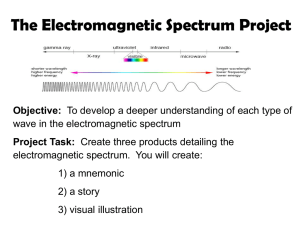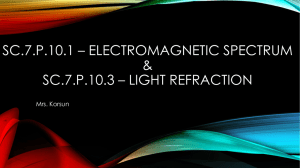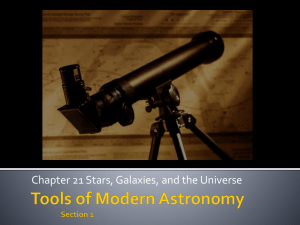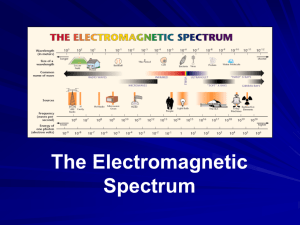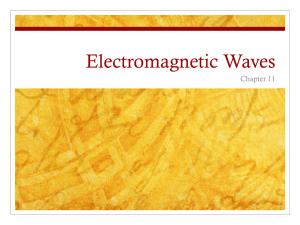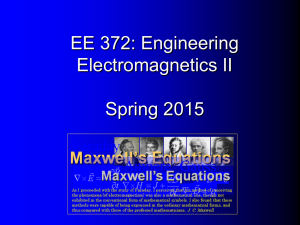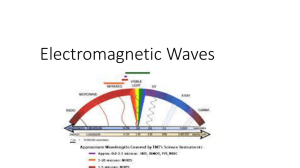Electromagnetic Spectrum
advertisement
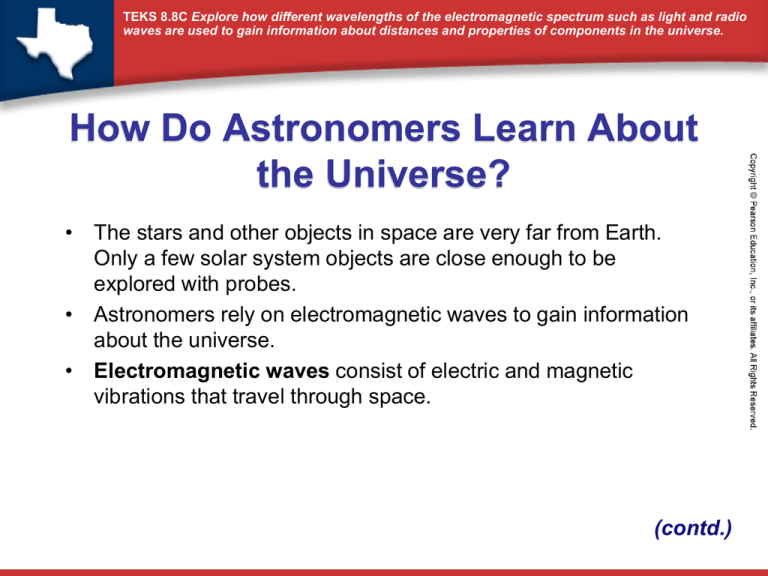
TEKS 8.8C Explore how different wavelengths of the electromagnetic spectrum such as light and radio waves are used to gain information about distances and properties of components in the universe. How Do Astronomers Learn About the Universe? • The stars and other objects in space are very far from Earth. Only a few solar system objects are close enough to be explored with probes. • Astronomers rely on electromagnetic waves to gain information about the universe. • Electromagnetic waves consist of electric and magnetic vibrations that travel through space. (contd.) TEKS 8.8C Explore how different wavelengths of the electromagnetic spectrum such as light and radio waves are used to gain information about distances and properties of components in the universe. • The electromagnetic spectrum consists of all the wavelengths of electromagnetic radiation. • The electromagnetic spectrum includes light, radio waves, X-rays, gamma rays, and ultraviolet and infrared radiation. TEKS 8.8C Explore how different wavelengths of the electromagnetic spectrum such as light and radio waves are used to gain information about distances and properties of components in the universe. What are Telescopes? • Telescopes are instruments that collect electromagnetic radiation and bring it into focus. • Optical telescopes collect visible light. • Radio telescopes detect radio waves. • The Spitzer Space Telescope captures images in the infrared portion of the spectrum. • The Chandra X-ray Observatory captures images in the X-ray portion of the spectrum. 1. Compare How are all telescopes the same? TEKS 8.8C Explore how different wavelengths of the electromagnetic spectrum such as light and radio waves are used to gain information about distances and properties of components in the universe. What Information Can Radio Waves Provide? • Radio waves have provided scientists with valuable information about the universe. • Regular pulses of radio waves from space led astronomers to discover spinning neutron stars called pulsars. • After astronomers detected faint radiation on their radio telescopes coming from all directions, they hypothesized that this cosmic background radiation is the leftover thermal energy from the big bang. TEKS 8.8C Explore how different wavelengths of the electromagnetic spectrum such as light and radio waves are used to gain information about distances and properties of components in the universe. What Information Can Visible Light Provide? • Because of the vast distances in the universe, astronomers use the light year to measure distances in space. A light year is the distance light travels in a year. • Astronomers have learned that all known stars, including the sun, have a nearly identical chemical composition. An astronomer analyzing a star or another component of the universe often starts by studying the object’s spectrum. 2. Explain How are astronomers able to determine the chemical composition of stars? TEKS 8.8C Explore how different wavelengths of the electromagnetic spectrum such as light and radio waves are used to gain information about distances and properties of components in the universe. What Information Can X-rays Provide? • A black hole is an object with gravity so strong that nothing, not even light, can escape. • No light, radio waves, or any other form of radiation can escape a black hole, so it is not possible to detect black holes directly. • Astronomers detect X-rays coming from hot gas located near a black hole and infer that a black hole is present. TEKS 8.8C Explore how different wavelengths of the electromagnetic spectrum such as light and radio waves are used to gain information about distances and properties of components in the universe. What Other Information Might Electromagnetic Waves Provide? • By studying the shift of color of the light from stars, astronomers discovered a planet revolving around an ordinary star like our sun. • Since this first discovery, more than 300 planets have been discovered around other stars. • The discovery of new planets brings up the question of whether there is life in other solar systems. 3. Make a Hypothesis How might electromagnetic waves help scientists discover life on other planets?

